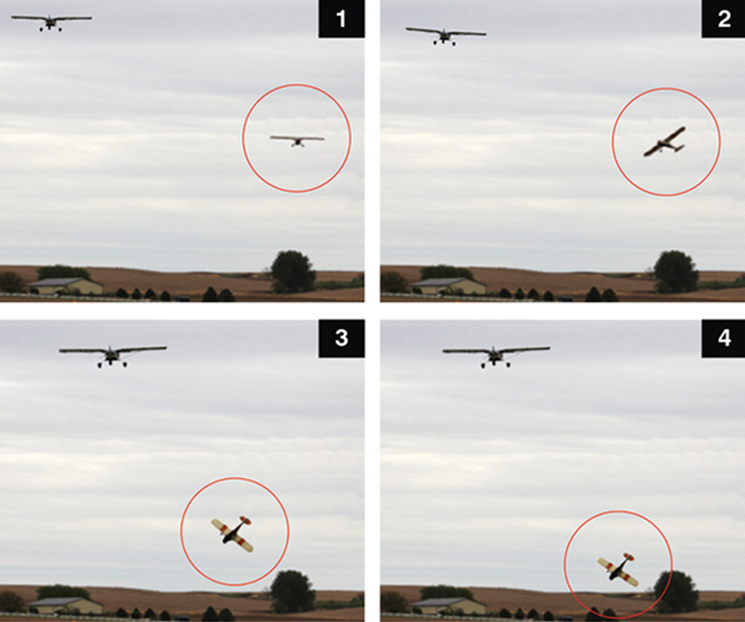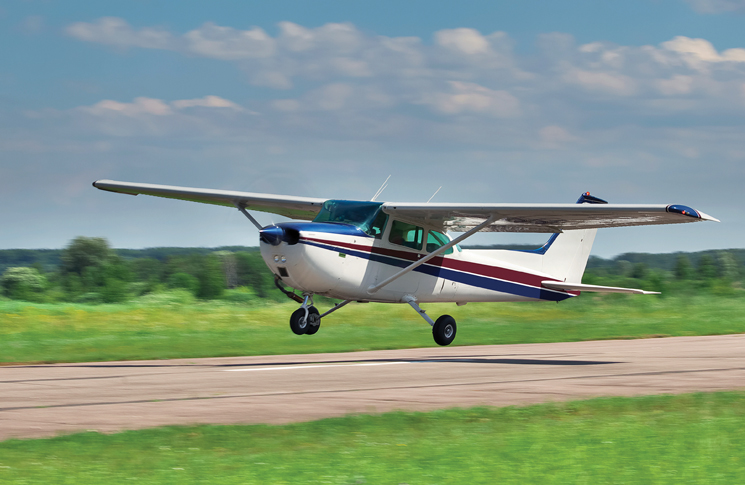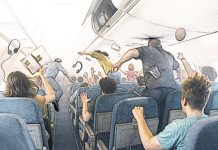Striving for accuracy in landings will benefit every phase of your flying.
It’s fun to be the ace of the base and win a spot landing contest – touch down smoothly and under control, as close to a line or marker on the runway as possible, without landing short of the mark.
To be consistently good at spot landings you must master 3 skills: airspeed control, glide path control and the timing of the landing flare to turn your precision approach into a contest-winning precision touchdown. But being good at accurate landings has benefits far beyond winning the adoration of your fellow fliers. Spot-landing contests are fun – they’re also great preparation for all your flying.
Any manoeuvre requiring precision, including obstacle takeoffs, high-density altitude, aerial photography, flight near or at maximum weight and emergencies, requires accurate airspeed control. A few knots here or there makes the difference if an engine fails, in singles as well as twins. Master airspeed control in spot landings and you can apply it to all your flying.
Flying a consistent glide path to arrive at a precise touchdown spot is great practice in what is called flight path management. That’s a fancy way of saying the ability to make the aeroplane go precisely where you want. There are a few more obvious ways of detecting the effect of your control inputs on your flight path than a chalk line marking where you’ll win the spot landing contest. But with this practice, you can also learn to manage the aircraft’s flight path through normal manoeuvres and critical survival skills like an engine-out glide to an off-airport landing.
Mastering flight path management does you no good if you can’t make a smooth transition to the next phase of flight. In an engine-out emergency, you have only one chance to get it right – avoiding a stall into your emergency field by flaring too soon or impacting hard or running off the end of the paddock by flaring too late. Even normal landings often come up short or end up running off the end of the runway.
The key to good consistent landings is for the pilot to get the aircraft in the slot on short final, no less than 500 feet above ground.
In the slot
It’s said – correctly – that a good landing is the result of a good approach. To win the spot landing contest, or to master any landing, aim for a position and aircraft condition in the last kilometre or so of your landing where all the conditions are set for arrival. Although the precise altitude may vary, let’s use 500 feet above field elevation for both visual and IFR approach procedures. As your aeroplane passes through 500 feet, it should satisfy all of these conditions to safely continue to landing – conditions when collectively met, I call being ‘in the slot’:
Airspeed is on target for touchdown. Generally, this will be 1.3 times the stalling speed in the aircraft’s current configuration at its current weight unless the manufacturer recommends otherwise. This may be a computed or tabulated indicated airspeed from the aeroplane flight manual (AFM) or pilot’s operating handbook (POH).
The indicated angle of attack, if an AoA sensor is installed, is on target.If the AFM or POH calls for flying a specific AoA on short final, or an approved aftermarket AoA device contains specific indications to attain on short final, then this becomes a condition for being ‘in the slot.’ If you have an AoA indicator that is supplemental, i.e., it is not approved by a type certificate, or a supplemental type certificate, you may from experience determine an approximate AoA pattern that correlates to being on the proper airspeed in 1G flight when passing through the 500-foot point. Crosscheck this supplemental indication against airspeed, but airspeed remains primary in such installations.
The aeroplane’s attitude is correct for the type of landing being performed (normal, short-field). Pitch attitude, whether visually out the windows or depicted on an attitude indicator or attitude/heading reference system display, will be consistent for a given indicated airspeed and/or AoA at a given center of gravity location and aircraft configuration (flap and landing gear position).
Aeroplane configuration is correct for landing – flaps set as required or desired and, of course, gear down in retractable gear aeroplanes.
Engine power is as expected for the landing. Attitude + power + configuration = performance. In this case performance results in the proper combination of indicated airspeed and vertical speed at the correct power or thrust setting.
The aeroplane is on glidepath and aimed to a landing in the runway’s touchdown zone. This is usually 150 metres from the runway threshold or one-third of the total usable runway length, whichever is shorter. In the case of a short-field landing, you may have to use a touchdown zone closer to the arrival end of the runway, using great care to avoid coming in short or too low over obstacles in the final approach path.
The aircraft is aligned with the runway centreline with zero sideslip. If on finals you don’t have any crosswind under control, it’s not likely you’ll be able to get it under control before the aeroplane touches down.
The aeroplane’s vertical speed is on target to carry it on the glidepath from 500 feet to the touchdown zone.
If any of those variables is off on short final, you are not ‘in the slot’ and there is increased risk of a runway undershoot or overrun, stall, hard landing or loss of directional control on the runway. You’re not going to win the spot landing contest. Power up, go around, re-enter the pattern and try for greater precision in another attempt. Or divert to another runway or airport if conditions are such you cannot get in the slot next time around.
Stabilised approaches have been proven to save lives.
Stabilised approach
Why does everyone talk about stabilised approaches? Because, as said, a good landing starts with a good approach. The concept of stabilised approaches has evolved to meet these goals:
- predicting aircraft performance by using a consistent technique every time
- increasing situational awareness by allowing the pilot to focus on instrument or outside references, as appropriate to conditions, instead of diverting attention to changing trim, power and configuration settings during final approach
- more easily detecting and correcting for glidepath deviations
- increased ability to establish crosswind corrections
- landing in the touchdown zone at the proper speed to ensure landing performance.
Common accidents where a stabilised approach is not flown include controlled flight into terrain, landing short, landing long, running off the far end of the runway and stalls. Stabilised approaches have been proven to save lives.
Are we concentrating too much on a buzzword, the stabilised approach? Or is a technique that goes beyond the definition of stabilised approach – one that puts the aeroplane in the slot on short final – a better way to go?
The key to good consistent landings is for the pilot to get the aircraft in the slot on short final, no less than 500 feet above ground. The conditions of the slot (airspeed, AoA, attitude, configuration, power, glidepath, aiming spot), in turn, serve as a final quality control check of the pilot’s landing technique. Is the aeroplane in the slot as you pass through 500 feet on short final? Continue to flare and land. Is the aeroplane not completely in the slot on short final? Power up and go around.
The stalls that happen in most accidents are not the stalls that we think appearin most accident reports.
Spot landing gone bad
The US National Transportation Safety Board reports:
On May 20 2022, a Cessna 140 was destroyed when it impacted terrain near the Wayne Municipal Airport in Nebraska. The private pilot was fatally injured. According to a representative with STOL Drag Events LLC., which participated in the 2022 Wayne County Mayday STOL [short takeoff and landing] drag races, the day before the accident the event began with short takeoff and landing drag racing (‘STOL Drag’) training, conducted on a course next to runway 5/23. The accident pilot had been signed off for competition at a prior STOL Drag event. On the day of the accident, additional STOL Drag training had been completed in the morning and qualifying STOL Drag races were planned for the afternoon. However, due to the north-west gusting winds, the qualifiers were postponed until the next day.
After the postponement decision was made, several of the competing pilots expressed a desire to perform a traditional spot landing contest (without any drag racing component) on the grass runway 31 given the favorable headwinds. A safety briefing was held with STOL Drag representatives, Federal Aviation Administration inspectors and pilots who planned to fly in the traditional STOL. A representative with STOL Drag informed the pilots that the flying was optional and it was not a part of the formal competition. To limit pattern congestion, multiple groups of 5 airplanes were organised.
According to multiple witnesses and video/photographic evidence, the accident airplane was the last airplane within the group of 5 and 2 landings had been performed without incident. During the third approach, with the accident airplane on final approach and following a Zenith STOL 701 also on final, the accident airplane descended and appeared to be lower than the airplane ahead. Subsequently, the pitch attitude increased, the airplane rolled to the right, completed a 3/4 turn right spin and impacted terrain in a near vertical attitude, as shown in the figure with the accident airplane circled in red.
The STOL Drag representative who coordinated the pattern operations over the radio reported that, about 45 seconds prior to the accident, he stated over the radio to the accident pilot, ‘Lower your nose you look slow.’ About 15 seconds before the accident, he stated again to the accident pilot, ‘Lower your nose.’ There were no communications received from the accident pilot and none of the other pilots in the pattern were talking on the radio near the time of the accident.
The airplane came to rest about [485 meters] from the runway 31 threshold and about [75 meters] right of the extended centerline. The airspeed indicator needle was found indicating about 57MPH and a rub mark at this speed was observed on the face of the instrument. The left seat lap belt was found belted. Shoulder harnesses were not installed.
About the time of the accident at the airport, an hourly observation reported that wind was from 290° at 15 knots, gusting to 21 knots, which was consistent with the video that showed tall flags positioned at the runway threshold. The video showed that the gusting wind varied from about 290° to a direction nearly aligned with runway 31.’

Three things occur to me as a result of this tragedy:
- The stalls that happen in most accidents are not the stalls that we think appearin most accident reports. The much-feared base-to-final turn stall is far less common than stalls after making the turn to final, in a go-around and on initial takeoff. Don’t think you’ve got it made aerodynamically just because you’re wings level on final approach.
- Don’t wait too long to go around. If you’re not ‘in the slot’ or on a clear trend to get into the slot before you cross the runway threshold, begin a smooth go-around before you get too slow or too low to the ground.
- The skills needed to win a spot landing contest are the same skills we should exercise and strive to master for every landing – including determining whether you’re in the slot and then executing a timely go-around decision.
The real spot landing contest isn’t against other pilots at the fly-in at Wagga or wherever pilots gather. The real contest is against yourself, trying to better your score every time by touching down smoothly on your intended target at the proper speed and in the proper aircraft configuration, aligned with the runway centreline with no slideslip and with the runway stripes, if the runway is sealed and marked, between the main wheels.





